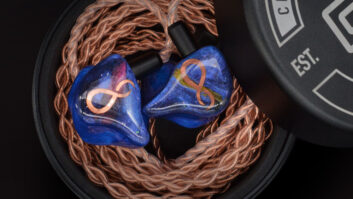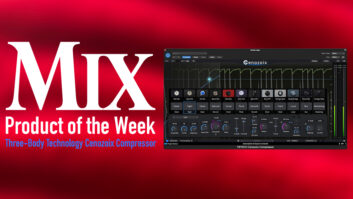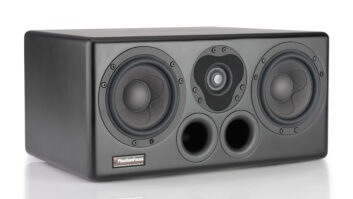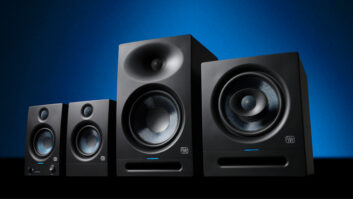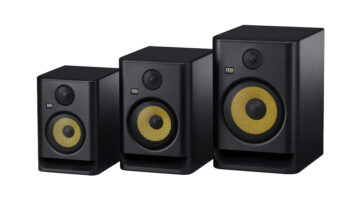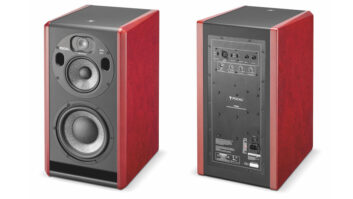The Linn name may be new to the studio community, but this Glasgow, Scotland — based manufacturer has been building audiophile gear for more than three decades and launched its acclaimed record label in 1981. What’s new is the company’s entry into the professional audio market with its 318A and 328A active studio monitors.
Linn examined every aspect of the monitoring system to create a new, yet uncompromising design. Perhaps the most striking part of its flagship 328A ($16,000 each) is its radical enclosure design, where parallel surfaces are simply not found. The top panel slants downward; the wide oval front baffle houses twin 8-inch woofers that flank a central driver array with a 3-inch dome midrange, a 1-inch tweeter and a ½-inch super-tweeter that kicks in at 11.5 kHz and extends beyond 33 kHz (-3 dB).
Under the hood, there’s a whole lot going on in this active four-way system. The two LF drivers are servo-controlled using an accelerometer on each cone that sends data to closed-loop feedback circuits. Intended to reduce distortion, these ensure that the 500-watt amp driving each woofer constantly produces the exact drive current required for cone motion that precisely reproduces the input signal, with a -3dB down-point of 20 Hz (-6 dB at 15 Hz).
Linn’s patent-pending 3-K driver array — a sealed-back-shaped aluminum slab that houses the dome mid/high drivers, with a smooth front to avoid acoustical diffraction effects and the array’s thick slab construction — is rock-solid and free of any unwanted resonances. Meanwhile, what appears to be a front port is actually an acoustically shaped chamber behind the baffle plane, with the tweeters centered in the space. This minimizes the area behind the high-frequency drivers, totally isolating them from the front baffle itself. At the same time, the entire 3-K array is mounted at the monitor’s acoustic center, and the tight placement of the mid and high drivers creates the effect that all frequencies are emanating from a single point source.
All of the active crossovers are Linkwitz-Riley types with 24dB/octave slopes and are fixed at 594 Hz (LF to MF), 4.1 kHz (MF to HF) and 11.5 kHz (HF to XHF). The 500 watts (250W MF/125W HF/125W XHF) driving the 3-K array brings the total power in each 328A to a whopping 1,500 watts. Linn specs the 318A monitors as capable of maximum SPLs in the 110dB range. They aren’t kidding. With the thick, non-resonant MDF-based Hornflex cabinet, heavy rear heatsinks to keep amplifier temperatures in check, drivers and associated electronics, the 26.5×11×22.5-inch monitors weigh in at nearly 100 pounds each. You’ll appreciate the built-in side handles if you need to move these.
The rear panel has a Neutrik Combo ¼-inch/XLR connector that handles balanced or unbalanced inputs and can be set for -10dBV or +4dBu levels. The electronics can run at any voltage from 100- to 240 VAC. The 318As sound fine as is, but LF and HF controls are provided for user taste or tweaking for room/system variations. A ±1.5dB shelf offers treble cut/boost. On the bass side, controls include a switchable -12dB/octave roll-off at 19 Hz or 50 Hz and a 3dB boost from 19 to 80 Hz. Should more LF be required, an optional subwoofer is available.
I had the opportunity to audition a 5.1 version of the 318As during a demonstration in the 48-seat screening room at the Saul Zaentz Film Center in the Fantasy complex in Berkeley, Calif. On playback from a variety of media — SACD, DVD-A and DVD-V — the monitors had no problem providing ample levels, even with the size of the room. At one point, I asked to hear the system without the subwoofer to get a better feeling about its bass response, but I was surprised to find out that the sub was off.
Also, Linn describes the 318As as near-fields or mid-fields, but these monitors are definitely in the latter category; stand-mounting is a preferred option to balancing two or three of these on a meter bridge. But whether listening close or at a distance, the spectral balance was wonderfully natural, with pinpoint imaging and an accurate soundstage from stereo or surround playbacks. One nice feature of the 318As is the cabinets’ low profile, which not only makes them easier to integrate into a studio with soffit-mounted mains, but also simplifies placement in a sound-for-picture environment, where the center channel won’t block the screen.
The 328As are substantial monitors, but for those who need something downscaled, Linn also offers the $11,000 318A, a single-woofer version with 1,000 watts of active amplification and the same 3-K MF/HF array, but in a more compact, conventional (rectangular) enclosure. Having the same voicing as the 328As but with less bass SPLs, the 318As are suitable as stereo near-fields or as rear surrounds in a 5.1 system with 328As in the LCR positions. Either way, Linn has introduced impressive new contenders for the high-end pro monitor market.
For more information, visit www.linn.co.uk or call 904/645-5242.
George Petersen is Mix’s editorial director.
